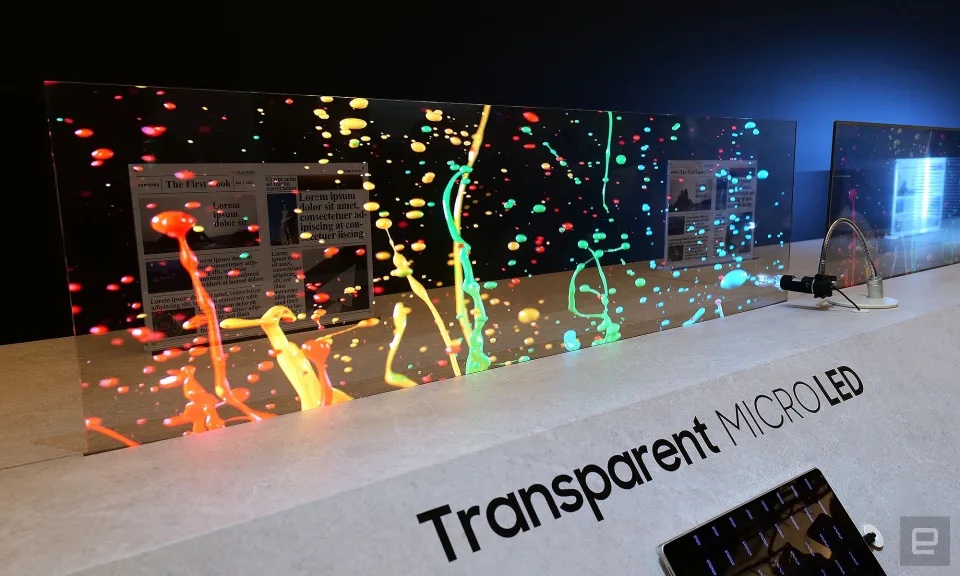
Samsung Teases Frameless Transparent MicroLED Display At CES
January 8, 2024 by Dave Haynes
Photo Credit – Sam Rutherford/Engadget
CES is this week in Las Vegas, and while a hell of a lot of the reporting that comes out of the giant consumer tech show will involve stuff that will never really be available to buy and use, there are glimpses as always of what’s coming somewhere down the road.
The one time I went to CES, years and years ago, I saw very early OLED displays in the Sony stand. It took a while, but they mainstreamed.
Technology brands of all sizes and pedigrees are pushing out press this week about new gadgets or enhanced lines. The biggest fanfare tends to come from the biggest companies, like Samsung. The Korean giant is talking about new QLED and OLED displays, as well as AI enhancements and a growing app ecosystem. Most of that, understandably, has to do with consumer TVs.
But the company is also showing, this week, a transparent microLED display.
From Engadget:
On Sunday night Samsung held its annual First Look event at CES 2024, where the company teased the world’s first transparent MicroLED display. While there’s still no word on how much it costs or when this tech will find its way into retail devices, Samsung showcased its transparent MicroLED display side-by-side next to transparent OLED and transparent LCD models to really highlight the differences between the tech.
Compared to the others, not only was the MicroLED panel significantly brighter, it also featured a completely frameless design and a more transparent glass panel that made it easier to see objects behind it.
Here’s a weirdly crappy video posted by Samsung:
And here’s a better one posted by Abhi Verma of Regency Digital Media.
So this is tech one would think has more application as a commercial product than one for consumers – with architectural glass that can look like any other glass that acts as a divider, or maybe as a window.
The Samsung explainer on what this is is VERY vague – describing the MicroLED chips only as being “extremely small” and using a “precision manufacturing process that eliminates seams and light refraction. This allows the transparent MICRO LED to create a clear, unobstructed picture for various use cases in both homes and B2B environments.”
Touting a modular design that allows users to personalize the shape, size and ratio of screens to fit any space, MICRO LED is a truly innovative screen technology. Samsung’s years of research and development — stemming from its semiconductor expertise — have led to an extremely effective process, allowing LED chip operation circuits to be directly deposited on the glass and thereby mitigating the loss of brightness that users may experience with conventional displays.
The directly deposited on the glass thing is interesting, because most of the product out there that’s related to window and divider glass is a film or micro-thin perforated wafer adhered to glass. There are LED products based on the chips being embedded in architectural glass, but the pixel pitches are such that they are best viewed from a bit of distance. To make the pitches tighter with those, the transparency starts to go away.
I’ve seen suggestions that this is a world’s first, and maybe it is in terms of something that is product-y (new word). But I have clear memories of seeing a transparent microLED R&D display years ago, pre-COVID, in Taiwan. Quite possibly at SID’s Display Week, as well.
This is trade show bling, so don’t expect to see it commercialized for some time. As mentioned in the past, the only people who can afford “regular” non-transparent microLEDs are hedge fund CEOs and Manchester City strikers. A 110-inch microLED TV costs north of $100K.
But it shows where things are likely going with displays, and how microLED will, over time, further the notion of all kinds of surfaces being displays.



The problem with transparent LED has never been the LEDs. It’s been getting enough power to them to make them bright enough. More power means thicker wires which are less transparent (they’re opaque but the trick is you only use a few % of the glass for wires).
So either they’ve got a huge efficiency breakthrough in the LEDs, or they’ve found a new material to make the wires out of its higher conductivity, or transparency.
yes, I’d like to see some specs and have an up-close look … this is bling I assume we will also see at the Samsung stand at ISE … hopefully they don’t repeat 2023 and insist on walk-up attendees scheduling a formal, guided tour … no, sorry, I’m not interested in your whiteboards and nice curvey desktop monitors